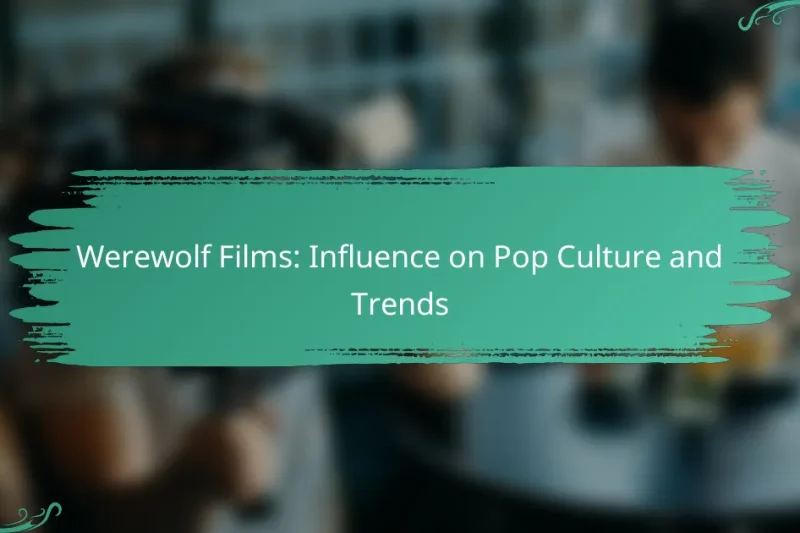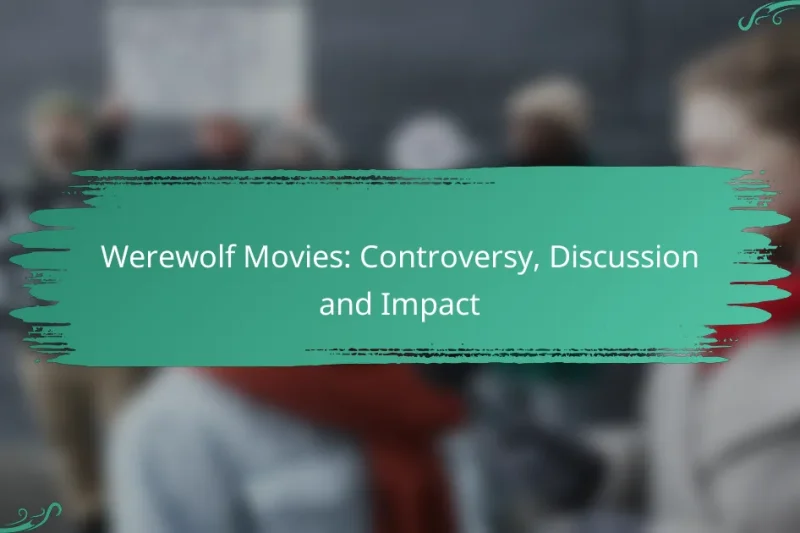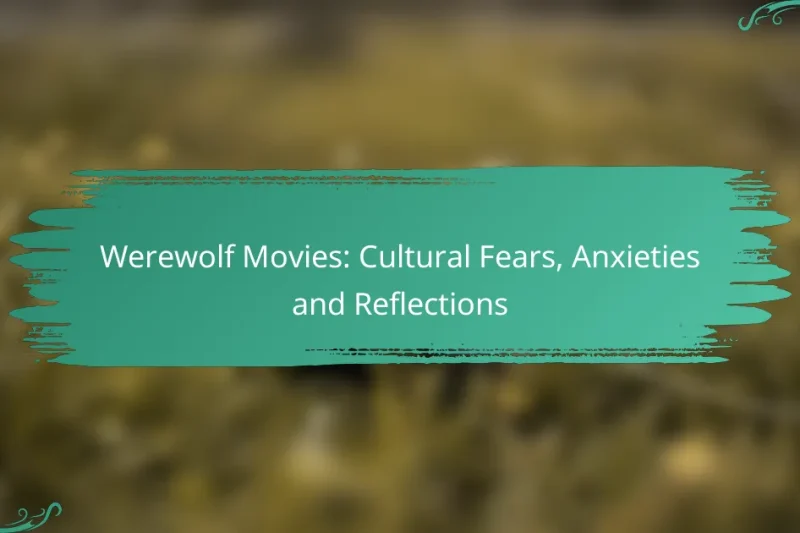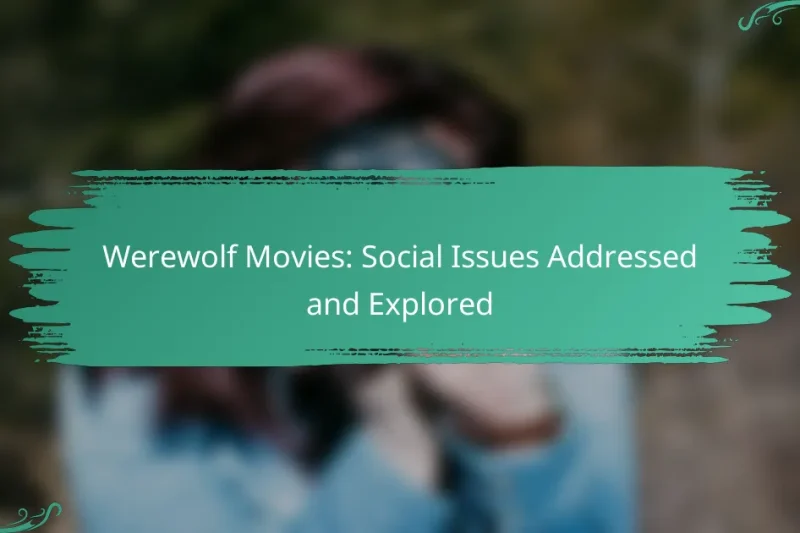Werewolf films have left an indelible mark on American pop culture, influencing entertainment, fashion, and seasonal … Werewolf Films: Influence on Pop Culture and TrendsRead more
Cultural Impact of Werewolf Movies
Werewolf movies have a profound cultural impact, delving into themes of transformation, identity, and the duality of human nature. By reflecting societal fears and personal struggles, these films resonate with audiences and influence perceptions of folklore and self-identity. As they evolve with cultural shifts and technological advancements, werewolf narratives continue to explore complex issues that mirror contemporary anxieties.
Werewolf Movies: Inspiration for Other Media and Genres
Werewolf movies have left a lasting impact on modern horror and beyond, introducing intricate characters and … Werewolf Movies: Inspiration for Other Media and GenresRead more
Werewolf Movies: Controversy, Discussion and Impact
Werewolf movies have captivated audiences by merging horror, fantasy, and sometimes comedy, with iconic films like … Werewolf Movies: Controversy, Discussion and ImpactRead more
Werewolf Movies: Cultural Fears, Anxieties and Reflections
Werewolf movies serve as a lens through which cultural fears and anxieties are examined, particularly those … Werewolf Movies: Cultural Fears, Anxieties and ReflectionsRead more
Werewolf Movies: Social Issues Addressed and Explored
Werewolf movies in the United States provide a unique platform for exploring significant social issues, such … Werewolf Movies: Social Issues Addressed and ExploredRead more
How do werewolf movies influence cultural perceptions?
Werewolf movies significantly shape cultural perceptions by exploring themes of transformation, identity, and the duality of human nature. They often reflect societal attitudes towards fear, power, and the unknown, influencing how audiences view both folklore and personal identity.
Shaping views on masculinity
Werewolf films frequently portray male characters undergoing a transformation that symbolizes a struggle with masculinity. The physical change into a wolf often represents the conflict between civilized behavior and primal instincts, challenging traditional notions of masculinity.
For instance, characters like David in “An American Werewolf in London” experience a loss of control, which can resonate with societal fears about male aggression and vulnerability. This duality prompts viewers to reconsider what it means to be masculine in contemporary culture.
Impact on folklore and mythology
These movies often draw from and reshape existing folklore and mythology, bringing ancient tales into modern contexts. The portrayal of werewolves can revive interest in cultural legends, leading to a resurgence in folklore studies and adaptations.
Films like “The Wolfman” reinterpret classic myths, blending horror with cultural narratives, which can influence how these stories are passed down through generations. This connection to mythology reinforces the idea that folklore remains relevant in understanding human fears and desires.
Reflection of societal fears
Werewolf movies serve as a mirror to societal fears, particularly regarding the loss of control and the unknown. The transformation into a werewolf often symbolizes deeper anxieties about identity, mental health, and societal norms.
For example, during periods of social upheaval, werewolf films may highlight fears of the “other,” reflecting anxieties about outsiders or changes in societal structure. This thematic exploration allows audiences to confront their fears in a controlled environment, providing both entertainment and a means of reflection.
What are the key themes in werewolf films?
Werewolf films often explore themes of transformation, identity, isolation, and the conflict between nature and nurture. These themes resonate with audiences by reflecting deeper societal fears and personal struggles.
Transformation and identity
Transformation is a central theme in werewolf movies, symbolizing the struggle between one’s human side and primal instincts. Characters often face a dual identity, grappling with their humanity while succumbing to their beastly nature. This theme raises questions about self-acceptance and the hidden aspects of one’s personality.
For example, films like “An American Werewolf in London” showcase the physical and psychological changes that occur during transformation, highlighting the character’s internal conflict. This transformation can serve as a metaphor for adolescence, addiction, or other life changes that challenge one’s identity.
Isolation and community
Isolation is frequently depicted in werewolf narratives, where characters are often ostracized due to their condition. This theme emphasizes the loneliness that comes with being different, as well as the fear of rejection from society. The werewolf’s curse can symbolize the alienation felt by individuals who struggle to fit in.
Conversely, some films explore the importance of community, where characters band together to confront the werewolf threat. This dynamic illustrates the power of solidarity and support in overcoming personal and collective fears, as seen in movies like “The Howling.”
Nature vs. nurture
The conflict between nature and nurture is a recurring theme in werewolf films, questioning whether one’s behavior is determined by biology or environment. Characters often wrestle with the innate urges of their werewolf side against the moral and ethical teachings of their upbringing.
Films like “Ginger Snaps” delve into this theme, showcasing how external influences and personal choices shape a character’s actions. This exploration can lead to discussions about the impact of societal expectations and personal responsibility in shaping one’s identity and behavior.
How have werewolf movies evolved over time?
Werewolf movies have transformed significantly from their early days, adapting to cultural shifts and technological advancements. Initially rooted in folklore, these films now explore complex themes of identity, fear, and societal issues, reflecting contemporary anxieties.
Classic films from the 1930s
The 1930s marked the emergence of werewolf films, with “Werewolf of London” (1935) and “The Wolf Man” (1941) setting the standard. These films introduced iconic imagery and themes, such as the struggle between humanity and primal instincts, which resonated with audiences during a time of social upheaval.
Classic werewolf films often featured a tragic hero, emphasizing the duality of man and beast. The transformation scenes were groundbreaking for their time, using practical effects to create a sense of horror that captivated viewers.
Modern interpretations in the 21st century
In the 21st century, werewolf movies have taken on new narratives, often blending genres such as horror, fantasy, and drama. Films like “Dog Soldiers” (2002) and “The Wolfman” (2010) showcase more sophisticated storytelling and character development, moving beyond simple monster tropes.
Contemporary werewolf films frequently address themes of isolation, societal rejection, and personal transformation, appealing to a broader audience. This evolution reflects changing cultural perspectives on identity and acceptance.
Influence of technology on storytelling
Advancements in technology have significantly impacted the storytelling of werewolf films. CGI and digital effects allow for more realistic transformations and action sequences, enhancing the overall viewing experience. This technology has made it possible to depict werewolves in ways that were previously unimaginable.
Moreover, streaming platforms have expanded the reach of werewolf narratives, enabling diverse interpretations and series that explore the lore in depth. This accessibility encourages a wider audience to engage with werewolf mythology, fostering new discussions and interpretations.
What are the cultural impacts of specific werewolf films?
Werewolf films have significantly influenced popular culture, shaping perceptions of the supernatural and human nature. These movies often explore themes of transformation, identity, and societal fears, resonating with audiences across different eras.
The Wolf Man (1941) and its legacy
The Wolf Man is a seminal werewolf film that set the standard for the genre, introducing iconic elements such as the full moon transformation and the tragic nature of the werewolf. Its exploration of duality and the struggle between humanity and primal instincts has influenced countless films and literature.
This film’s legacy is evident in its enduring popularity and the way it has been referenced in various media, from television shows to modern horror films. The character of Larry Talbot has become a cultural touchstone, symbolizing the internal conflict many face in their lives.
American Werewolf in London (1981) and humor
American Werewolf in London blends horror and dark comedy, showcasing how werewolf films can evoke both fear and laughter. The film’s unique approach to the werewolf mythos, particularly its special effects and comedic timing, has made it a classic.
This combination of genres has inspired filmmakers to incorporate humor into horror, creating a subgenre that appeals to a wider audience. The film’s memorable transformation scene remains a benchmark for special effects in cinema, influencing how werewolves are depicted in subsequent films.
Twilight series and youth culture
The Twilight series has had a profound impact on youth culture, particularly in its portrayal of werewolves as romantic figures. This shift from monstrous to relatable characters has resonated with younger audiences, redefining the werewolf archetype.
By integrating themes of love, loyalty, and friendship, the series has contributed to a broader acceptance of supernatural elements in mainstream media. The popularity of the Twilight saga has led to a resurgence of interest in werewolf narratives, influencing fashion, literature, and even social dynamics among teens.
How do werewolf movies compare to other horror genres?
Werewolf movies stand out in the horror genre due to their unique blend of folklore, transformation, and the exploration of human nature. Unlike other horror films, they often delve into themes of identity and the struggle between civilization and primal instincts.
Differences from vampire films
Werewolf movies differ from vampire films primarily in their portrayal of transformation. While vampires maintain their human form and intellect, werewolves undergo a physical and mental change that often leads to loss of control. This transformation symbolizes the battle between humanity and animalistic urges.
Additionally, werewolf narratives frequently emphasize the curse aspect, where the afflicted individual grapples with the burden of their condition. In contrast, vampires are often depicted as seductive and powerful, embracing their nature rather than resisting it.
Similarities with zombie narratives
Both werewolf and zombie films explore themes of loss of control and the breakdown of societal norms. In werewolf stories, the character’s transformation leads to violent behavior, similar to how zombies are depicted as mindless and aggressive. This loss of self is a central theme in both genres.
Moreover, both genres often highlight the struggle for survival against a monstrous threat, whether it be the werewolf within or the horde of zombies. Characters in these films must navigate their fears and confront their darker sides, making for intense psychological drama.
Crossover themes in supernatural horror
Supernatural horror films, including werewolf movies, often share themes of duality and the conflict between good and evil. The werewolf’s transformation can symbolize the internal battle between civilized behavior and primal instincts, a theme that resonates across various supernatural narratives.
Additionally, the exploration of curses and the supernatural is prevalent in both werewolf and other horror films, such as witchcraft or demonic possession. These themes create a rich tapestry of fear and moral questioning, inviting viewers to reflect on their own humanity.
What role do werewolf movies play in contemporary media?
Werewolf movies serve as a significant cultural touchstone in contemporary media, blending horror with themes of transformation and identity. They explore societal fears and personal struggles, often reflecting deeper issues such as the duality of human nature and the conflict between civilization and primal instincts.
Influence on TV series like Teen Wolf
TV series like Teen Wolf have drawn heavily from the werewolf genre, incorporating its themes into character development and plotlines. The show reimagines werewolves as complex characters, often dealing with adolescence and personal growth, which resonates with younger audiences.
Additionally, Teen Wolf’s success has led to a resurgence of supernatural themes in television, influencing other series to explore similar motifs, such as identity crises and the challenges of fitting in.
Merchandising and fan culture
The popularity of werewolf movies has spurred a robust merchandising culture, with products ranging from clothing to collectibles. Fans often engage with these items as a way to express their passion for the genre and connect with others who share similar interests.
Conventions and fan events centered around werewolf films foster community, allowing enthusiasts to celebrate their favorite characters and stories through cosplay and discussions, further solidifying the genre’s impact on popular culture.
Impact on gaming and interactive media
Werewolf movies have significantly influenced gaming and interactive media, with many video games incorporating werewolf lore and mechanics. Titles like The Wolf Among Us and Werewolf: The Apocalypse allow players to explore themes of transformation and morality, enhancing the immersive experience.
Moreover, the integration of werewolf narratives into role-playing games has created opportunities for players to engage in storytelling that mirrors the complex themes found in the films, making the genre relevant in the gaming community.




